Extracted from Conclusion:
"The results showed that no mitigation treatment was effective in all site years, but that in the years when treatments were effective, tramline modification was able to reduce losses of run-off, suspended sediment and total phosphorus by the greatest amount (69-99 per cent). Tramline management therefore has the greatest potential for reducing diffuse pollution in surface run-off from winter-sown cereals."
Deasy, Clare & Quinton, John & Silgram, Martyn & Stoate, Chris & Jackson, R. & Stevens, C. & Bailey, Alison. (2010). Mitigation Options for Phosphorus and Sediment (MOPS): Reducing Pollution in Runoff from Arable Fields.. The Environmentalist. 180. 12-17.


